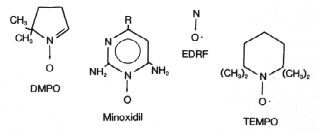
Endothelium-Derived Relaxing Factor and Minoxidil: Active Mechanisms in Hair Growth
In: Archives in Dermatology, vol 125, August, 1989
To the Editor. -Recent discoveries imply a role for the nitroxide free radical (NO) in the control of vascular tone, platelet function, and in the central nervous system.(1-2) The NO is apparently endothelium-derived relaxing factor, or EDRF,(1~2) an endogenous compound probably accounting for the action of nitrovasodilators such as nitroglycerin. Because many other vasodilators act by increasing the endothelial production and release of EDRF, the elucidation of this system has caused a revolution in vascular physiology.
Such discoveries may also explain the vasodilatory action of another nitro compound, whose name, "miNOxidil," betrays its chemical affinity to EDRF (Figure). That is, minoxidil or (more likely) an active metabolite may be an EDRF agonist. Further, EDRF and minoxidil both activate guanylate cyclase,(1-3) an action thought to account for their common vasodilatory properties and one that is shared by many electronically activated compounds. Perhaps a separate action of EDRF on hair growth also explains minoxidil-induced hypertrichosis.
_____________________________________________________
Various Nitroxides Relevant to Hair Growth

___________________________________________________________________________
Legend: Nitroxides form long-lived radicals. Spin traps such as DMPO (5,5 dimethyl-i -pyrroline-N-oxide) form stable adducts with short-lived radicals such as superoxide. Spin labels such as TEMPO (2.2,6.6-tetramethyl-1-piperidinyloxyl, free radical [0]) are stable radicals under biological conditions-the dot stands for the unpaired electron. Minoxidil itself resembles the spin traps, but the active form may be a radical analogous to endothelium-derived growth factor (EDRF) or TEMPO. Conversely, note that minoxidil is also a polyamine; cations (such as polyarginine) can show EDRF-like activity with activation of guanylate cyclase.
_____________________________________________________________________________
In addition, EDRF is a stable free radical. Significantly, other radical-formers such as psoralen plus UV-A, porphy-rins, and anthralin induce hypertrichosis, which also occurs in hairy nevi (eg, melanin as a stable radical species(4)). Thus, free radicals and the like may modulate hair growth as they apparently do inflammation, skin pigmentation, and neurotransmission.(4 ).
Conversely, stable radicals are often potent antioxidants. Indeed, NO is an important industrial antioxidant, while NO's reactivity with superoxide radical explains the potentiation by superoxide dismutase of EDRF action.(2). Perhaps hair growth reflects protective systems rather than the active processes themselves. Such opposed interpretations are common in free-radical biology. In this regard, we have observed stimulation of hair growth by certain oxygen radical scavengers (P.H.P., unpublished data, 1988).
Moreover, minoxidil closely resembles nitroxide spin labels and spin traps(4) (Figure). By scavenging superoxide, the nitroxide spin trap DMPO (5,5 dimethyl-1-pyrroline-N-oxide) ameliorates postischemic injury to heart muscle (5). It is likely that EDRF plays a similar function in ischemia and inflammation, for which there may be some (controversial) role in pattern loss. In fact, this may account for some of the protective action of nitrovasodilators in myocardial infarction. For example, many current models for postischemic myocardial and stroke-induced tissue damage involve a combination of calcium ions and free radicals. Since calcium channel blockers also induce hair growth, perhaps balding is ultimately related to similar processes.
Peter H. Proctor, PhD, MD
Some things that have changed since this paper was published:
1): Presently, the action of both nitric oxide and Minoxidil on vascular smooth muscles is thought to be due to opening of membrane potassium channels ( "K-Channel agonism") rather than their action on cyclic GMP. Superoxide blocks this. According to UpJohn researchers, K-channel angonism also accounts for the action of minoxidil on hair follicles.
2) As well as breaking down NO, the "bad" effect of superoxide on nitric oxide is now thought to include the toxic reaction product peroxynirite. TEMPO, DMPO, and similar agents may work in heart attack, stroke, etc. by competitively inhibiting the reaction of superoxide and nitric oxide to form peroxynitrite.
Bibliography:
1. Vanhouette PM. The endothelium: modulator of vascular smooth-muscle tone. N Engi J Med. 1988;319:512-513.
2. Moncada S, Radomski MW, Palmer RJM. Endothelium-derived relaxing factor: identification as nitric oxide and role in the control of vascular tone and platelet function. Biochen PharmacoL 1988;37:2495-2501.
3 Eoehme E, Graf H, Schultz C. Effect of sodium nitroprusside and other smooth muscle relaxants on cyclic GMP formation in smooth muscle. Adv Cyclic Nacleotide Protein Phosphorylation Res. 1978;9:131-143.
4. Proctor PR. Free radicals and human disease. In: CRC Handbook of Free Radicals andAntioxidants in Biomedicine. Boca Raton, Fla: CRC Press; 1989~:209-222.
5. Kramer JR, Arroyo CM, Dickens BF, Weglicki WE. Spin-trapping evIdence that graded myocardial ischemia alters post ischemic superoxide production. Free Radic Biol Med. 1987;3:153-158.
Keywords: alopecia free radical redox signaling nitric oxide nitrovasodilator messenger antioxidant apoptosis melanin spin trap nxy-059 minoxidil pbn dmpo disease human signaling superoxide s
peroxide ischaemic injury stroke heart attack hair loss inflammation alopecia atherosclerosis